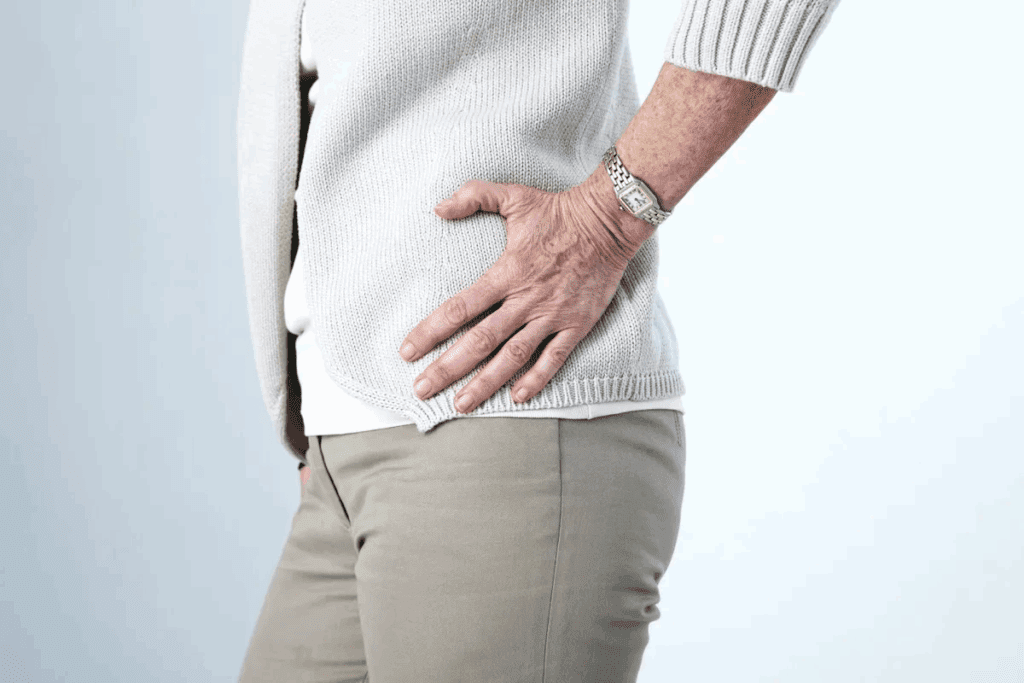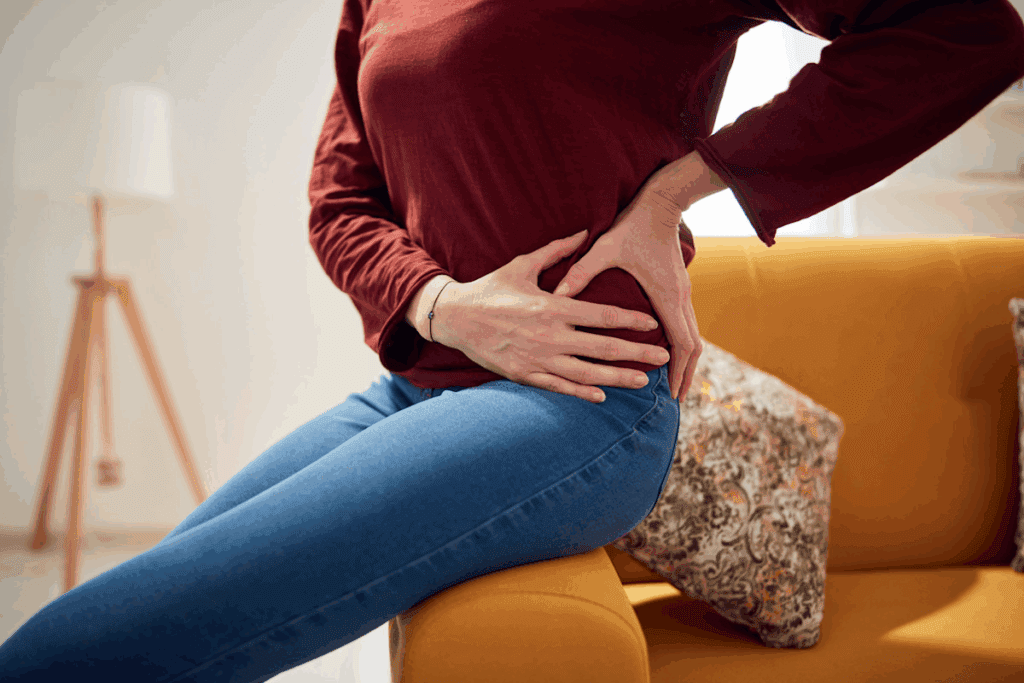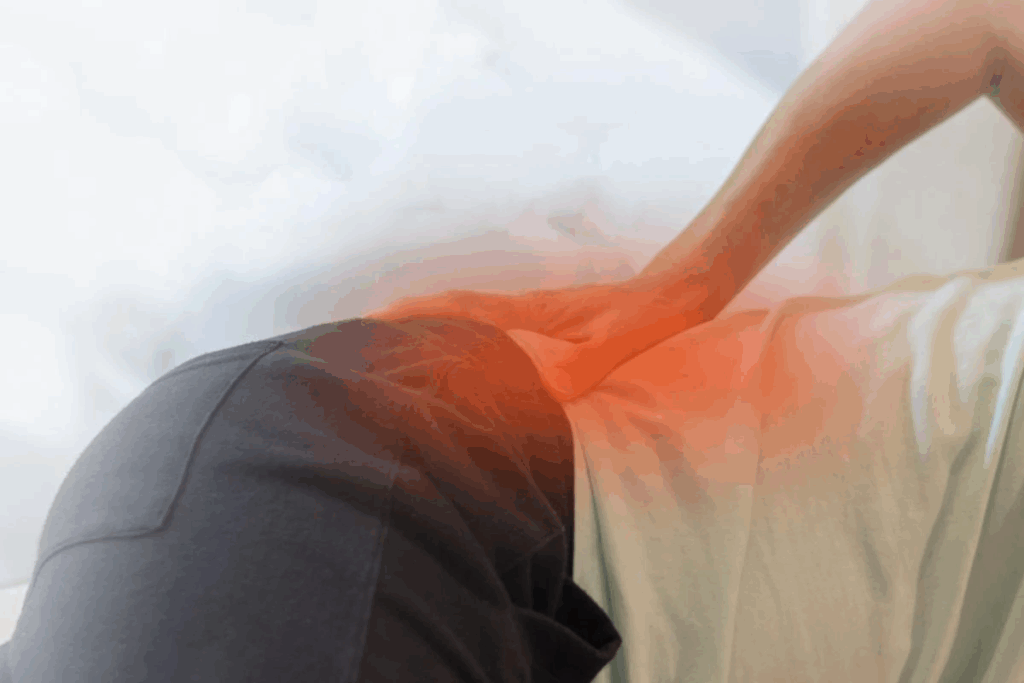Last Updated on November 4, 2025 by mcelik

Hip bursitis can really slow you down and make everyday tasks hard.
A comprehensive plan is essential for effectively addressing bursitis treatments. Simple steps like staying active, keeping a healthy weight, and quitting smoking can help. By trying different treatment options and making lifestyle changes, you can feel better and get back to normal.

Understanding hip bursitis is key for those with hip pain and limited movement. It’s a condition that affects the hip joint, causing discomfort and limiting movement. Knowing its causes and symptoms is vital for managing it.
A bursa sac is a fluid-filled pouch that reduces friction between bones, tendons, and skin. It plays a key role in smooth joint movement. In the hip, it cushions the area between bones and soft tissues, making movement easy.
The bursa sac has a lubricating fluid that reduces friction. This allows tendons and muscles to glide smoothly over bones. When it gets inflamed, it can cause pain, swelling, and limited mobility, typical of hip bursitis.

Hip bursitis often results from repetitive motion or direct trauma to the hip. Activities like running or cycling can irritate the bursa sac, causing inflammation. Direct blows to the hip or prolonged pressure on the bursa sac can also cause it.
Poor posture, uneven gait, or muscle imbalances can also contribute to hip bursitis. These factors can put extra stress on the hip joint, raising the risk of bursitis. Knowing these causes helps in preventing and treating it.
It’s important to recognize hip bursitis symptoms early for timely treatment. Common signs include pain on the outer hip or groin, tenderness, and limited mobility. The pain may get worse with activities like walking or climbing stairs.
Hip bursitis can also cause swelling or redness around the affected area. If not treated, it can lead to chronic pain and mobility issues. Seeing a healthcare professional is key if symptoms persist or get worse.
Bursitis isn’t just a hip problem; it can also affect the shoulder and wrist. This leads to pain and trouble moving. Knowing how it impacts other areas is key for proper treatment.
Shoulder bursitis affects the bursa sacs in the shoulder. Symptoms include pain, swelling, and limited mobility. Shoulder bursitis pain often spreads down the arm or hurts when lying on the affected side.
The shoulder has many bursae that can get irritated or inflamed. Repetitive arm movements, like throwing or lifting, raise the risk of shoulder bursitis. Knowing these risks helps in preventing and treating the condition.
Wrist bursitis is less common but can be quite painful. Symptoms include swelling, pain when moving the wrist, and sometimes redness. It usually comes from repetitive motion or direct trauma to the wrist.
Bursitis can also happen in the elbow and knee, though less often. Each location has its own challenges and needs specific treatment. By understanding bursitis in different areas, we can provide better care.
Getting a correct diagnosis for hip bursitis is key to treating it well. It involves both a doctor’s check-up and tests. Knowing the exact cause helps in choosing the right treatment.
First, we do a detailed check-up to spot hip bursitis. We check how well the hip moves and where it hurts. This includes:
These steps help us see if bursitis is there and if not, what else might be causing the pain.
Even with a physical check-up, we might need tests to be sure. We use:
| Imaging Test | Purpose |
| X-ray | To check for bone problems like fractures or osteoarthritis |
| Ultrasound | To see the bursa and soft tissues, spotting inflammation or fluid |
| MRI (Magnetic Resonance Imaging) | To get clear pictures of soft tissues, like tendons and bursae, to see inflammation and wear |
These tests let us see the hip’s parts and confirm bursitis.
X-rays usually don’t show bursitis itself. But, they help rule out other hip pain causes like fractures or osteoarthritis. If we think it’s bursitis, we might use ultrasound or MRI to see the inflamed bursa.
By using both doctor’s checks and tests, we can accurately find hip bursitis. Then, we can plan the best treatment.
Hip bursitis pain can be really tough to deal with. But, there are ways to get quick relief. You need to use both self-care and medical help to manage it well.
The RICE method is a good way to handle acute bursitis. It stands for Rest, Ice, Compression, and Elevation. It helps cut down inflammation and eases the pain.
Using the RICE method can really help lessen your pain and help your hip heal faster.
There are more ways to manage hip bursitis pain, aside from the RICE method. These include:
| Pain Management Technique | Description | Benefits |
| Medication | Over-the-counter pain relievers like NSAIDs | They cut down pain and swelling |
| Physical Therapy | Exercises tailored to strengthen hip muscles | They boost mobility and lessen pain |
| Corticosteroid Injections | Injections to lessen inflammation | They give a lot of pain relief |
These methods can be used together with the RICE method to help more with hip bursitis pain.
By mixing these strategies, you can better handle your hip bursitis pain. It’s key to talk to a doctor to find the best plan for you.
Bursitis treatment has improved a lot. Now, doctors have many ways to help with bursitis. They can reduce swelling and ease pain.
Prescription drugs are key in treating bursitis. Corticosteroids and NSAIDs help lower inflammation and pain. Sometimes, doctors inject corticosteroids directly into the bursa for better relief.
It’s important to know how these drugs work and their possible side effects. Corticosteroids, for example, can greatly reduce inflammation but might cause side effects with long-term use.
We team up with doctors to find the best medication plan for each person. This makes sure the benefits are worth the risks.
For those with hip bursitis, over-the-counter solutions can help a lot. These solutions often include medicine and changes in lifestyle. We’ll look at the best over-the-counter treatments.
Anti-inflammatory medicines are a common first choice for hip bursitis. Ibuprofen and naproxen are top picks. They help reduce pain and inflammation, making them great for bursitis symptoms.
When picking an anti-inflammatory, think about side effects and interactions. Always talk to a healthcare professional before starting any new medicine.
Topical treatments can also help with hip bursitis pain. Creams, ointments, and gels with arnica or capsaicin are good choices. They can be applied directly to the pain area, giving relief without the side effects of pills.
Some people find the best relief by using both oral and topical treatments. But, it’s important to follow the right dosage and application to avoid problems.
Understanding over-the-counter solutions for hip bursitis is a big step. Whether it’s through medicines or topical treatments, there are many ways to ease symptoms and improve life quality.
Physical therapy is key in treating hip bursitis. It uses various methods to lessen pain and boost movement. Adding specific exercises and stretches to your daily routine can greatly help your recovery.
Gentle stretching is vital for keeping the hip area flexible and less stiff. Effective stretches for hip bursitis include:
Do these stretches gently and within a safe range to avoid making the condition worse.
Strengthening the muscles around the hip is also important. It helps support and stabilize the joint. Key exercises include:
Strengthening these muscles helps in recovering from hip bursitis and prevents future issues.
By using these physical therapy methods, people can manage hip bursitis well. They can reduce pain and enhance their hip function.
Many home remedies and natural methods can help with hip bursitis. They work well with medical treatments to speed up recovery and improve health.
Heat and cold therapy are simple but effective for hip bursitis. Heat, like a warm bath or heating pad, relaxes muscles and boosts blood flow. Cold, such as an ice pack, reduces swelling and numbs pain.
For heat therapy, use a warm towel or heating pad on low for 15-20 minutes, several times a day. Cold therapy involves wrapping an ice pack in cloth and applying it for 10-15 minutes, also several times a day. Switching between heat and cold can be helpful, but listen to your body and adjust as needed.
Several natural substances have anti-inflammatory properties. These include:
These natural anti-inflammatory solutions can be added to your diet or taken as supplements after talking to a healthcare provider.
Diet is key in managing hip bursitis inflammation. Eating fruits, vegetables, whole grains, and lean proteins can help. Foods high in antioxidants and omega-3 fatty acids are also beneficial.
| Food Group | Examples | Benefits |
| Fruits | Berries, citrus fruits | High in antioxidants, vitamin C |
| Vegetables | Leafy greens, broccoli | Rich in antioxidants, vitamins |
| Proteins | Fatty fish, lean meats | Omega-3 fatty acids, protein for repair |
| Grains | Whole grains | High in fiber, vitamins, and minerals |
By adding these dietary changes and natural remedies to your life, you can lessen hip bursitis symptoms and boost your health.
Making certain lifestyle changes can speed up bursitis healing. By changing our daily habits and surroundings, we can ease symptoms and aid in recovery.
It’s key to change our activities when recovering from bursitis. We should modify our workouts, rest often, and avoid activities that stress the hip too much.
For example, people with hip bursitis might switch from running to swimming or cycling. Changing our daily activities can lessen stress on the bursa, helping it heal better.
“Rest is not idleness, and to lie sometimes on the grass under trees on a summer’s day, listening to the murmur of the water, or watching the clouds float across the sky, is by no means a waste of time.”
Making ergonomic changes is also important to avoid making bursitis worse. Simple tweaks, like using an ergonomic chair or adjusting our workspace, can ease hip strain.
| Ergonomic Adjustment | Benefit |
| Using an ergonomic chair | Reduces pressure on the hip |
| Adjusting workstation height | Minimizes strain on the hip joint |
| Taking regular breaks to stand and stretch | Improves blood circulation and reduces stiffness |
These lifestyle changes can help create a healing environment. By adjusting our activities and making ergonomic changes, we can better manage bursitis symptoms and speed up recovery.
Knowing how long it takes to heal from hip bursitis is key. It helps patients set realistic goals and follow their treatment plans well. The time it takes to recover can differ a lot. This depends on how bad the condition is, how well the treatment works, and the patient’s health.
In the first few weeks, patients start to feel better. Short-term recovery milestones include:
These early gains come from rest, physical therapy, and medicines that reduce swelling. It’s important for patients to stick to their treatment and make lifestyle changes to help heal.
While patients see progress in weeks, long-term healing expectations for hip bursitis can take months. Full recovery happens when the hip is strong and flexible again. The bursa also needs time to fully heal.
| Recovery Stage | Timeline | Key Milestones |
| Initial Recovery | 0-6 weeks | Less pain, better movement |
| Intermediate Recovery | 6-12 weeks | More strength, wider range of motion |
| Full Recovery | 3-6 months | Bursa fully healed, back to normal activities |
It’s vital for patients to keep in touch with their doctor. This way, they can track their progress and change their treatment if needed. By knowing the recovery timeline and following their treatment, people can increase their chances of a good recovery from hip bursitis.
Keeping your hip joints healthy is key to avoiding bursitis again. This can be done by exercising and making lifestyle changes. Knowing what causes hip bursitis and acting early can lower your risk of getting it again.
Building muscle around your hip joint is vital to stop bursitis from coming back. Regular exercise keeps the joint stable and lessens bursae strain. Here are some good exercises:
Hip specialists say, “A good exercise plan can greatly lower the chance of getting hip bursitis again. It improves joint mobility and strength.”
“Exercise is a cornerstone of prevention, not just for hip bursitis, but for overall musculoskeletal health.”
Along with exercises, certain lifestyle choices can also protect your hip joints. These include:
| Lifestyle Habit | Benefit |
| Maintaining a healthy weight | Reduces pressure on the hip joints |
| Avoiding repetitive strain | Minimizes wear and tear on the bursae |
| Wearing proper footwear | Improves gait and reduces hip stress |
By adding these habits to your daily routine, you can lower your risk of hip bursitis coming back. It’s also wise to avoid activities that might make it worse and get professional advice when needed.
It’s important to know when to get medical help for hip bursitis. Many cases can be treated at home. But, some need a doctor’s care to avoid more problems.
Some symptoms mean you need more than just home care. Look out for:
If you see these signs, get medical help right away.
Finding the right doctor for hip bursitis is key. Start by talking to:
Getting the right specialist early helps manage hip bursitis better.
There’s no single best way to treat bursitis. Different methods can help people feel better. It’s important to know all the options to make the right choice.
Doctors often use medicines and physical therapy for bursitis. Anti-inflammatory medications help with swelling and pain. Physical therapy makes joints move better and muscles stronger.
But, there are also other ways to treat bursitis. Acupuncture, herbal supplements, and physical therapies like ultrasound are some examples. These might not work for everyone, but they can help some people.
Using both traditional and alternative treatments can be even better. For example, taking medicines and doing physical therapy, along with acupuncture, can offer complete care.
| Treatment Approach | Benefits | Potential Drawbacks |
| Conventional Medications | Quick reduction in inflammation and pain | Potential side effects, dependency risk |
| Physical Therapy | Improves joint mobility, strengthens muscles | Requires commitment, may cause initial discomfort |
| Alternative Therapies | Holistic approach, fewer side effects | Effectiveness varies, may not be covered by insurance |
| Combination Therapy | Comprehensive care, potentially faster recovery | May require coordination between healthcare providers |
Knowing about different treatments helps people choose the best one. Working with a doctor, they can create a plan that fits their needs.
Recovering from hip bursitis needs a mix of treatments, management, and a recovery plan. Knowing the causes and symptoms is the first step. This helps people start their journey to get better.
A good treatment plan might include medical care, lifestyle changes, and self-care. This could be physical therapy, pain relief, and making your environment safer. These steps help you feel better and lower the chance of getting sick again.
We looked at different ways to treat hip bursitis, like using medicines, physical therapy, and home remedies. Picking the right treatment and making lifestyle changes can help you heal faster. This improves your life quality.
Bursitis is when the bursa sac, a fluid-filled sac, gets inflamed. This sac cushions joints and reduces friction. It happens from repetitive motion, direct trauma, or infection, causing pain and limited mobility.
Symptoms of hip bursitis include pain on the outer hip, tenderness, swelling, and limited mobility. Pain may get worse at night or with activities like climbing stairs.
Doctors diagnose hip bursitis through physical exams, medical history, and imaging tests. Tests like X-rays, ultrasound, or MRI help confirm inflammation and rule out other conditions.
The RICE method is a first-line treatment for acute bursitis. It stands for Rest, Ice, Compression, and Elevation. These steps help reduce pain and inflammation.
Over-the-counter NSAIDs like ibuprofen are often used to reduce inflammation and pain. For severe cases, prescription medications may be needed.
Yes, physical therapy is a key part of bursitis treatment. It includes stretches and strengthening exercises to improve mobility and reduce pain.
To manage hip bursitis pain at home, try applying heat or cold packs, using topical creams, and making ergonomic changes to reduce strain on the hip.
Adjusting activities, avoiding repetitive motions, and incorporating strengthening exercises can aid in recovery and prevent recurrence.
Recovery time for hip bursitis varies. It depends on the severity and treatment effectiveness. Short-term recovery milestones can be achieved in a few weeks, but long-term healing may take several months.
Yes, hip bursitis can recur. Prevention involves strengthening exercises, lifestyle habits that protect hip joints, and avoiding repetitive strain.
Seek medical help if symptoms worsen, or if you experience severe pain, swelling, or limited mobility. Consult a specialist for proper diagnosis and treatment.
Yes, alternative treatments include natural anti-inflammatory solutions, dietary changes, and therapies like acupuncture. Combining conventional and alternative approaches may yield optimal results.
Bursitis may not be directly visible on an X-ray. X-rays can help rule out other conditions like fractures or arthritis. Ultrasound or MRI may be used to confirm bursitis.
While lifestyle changes are important, they may not cure bursitis alone. A complete treatment plan often includes medical approaches and lifestyle modifications.
Subscribe to our e-newsletter to stay informed about the latest innovations in the world of health and exclusive offers!